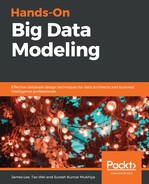The following list describes the main benefits of constructing LDMs:
- It facilitates an understanding of business data elements and their requirements
- It provides a foundation for designing the database
- It helps to avoid data redundancy and prevents data and business inconsistency
- It promotes data reusability and sharing
- It diminishes development, maintenance cost, and time consumption
- It confirms a logical process model and helps to impact analysis

Figure 4.3: LDM of the supermarket shown in Figure 4.2
The preceding diagram shows the LDM of the supermarket shown in Figure 4.2. At this modeling level, we try to answer the following questions:
- What should the collection look like?
- How can we make information secure?
- How should we store history information?
- How can we answer business questions in a shorter amount of time?
- What is the optimal way to perform sharding?
The LDM provides great mapping, in the case of multiple technologies. The LDM will explain one technology-independent perspective, and then we can map this business perspective to each of the various technology perspectives. Logical data modeling involves completing four steps, including filling in the CDM, normalizing and abstracting the model, determining the most useful form, and finally reviewing and confirming the logical model. The most common features of a logical model involve the following:
- All entities and relationships among the model are given
- All attributes are specified for each entity
- The primary key is specified for each entity
- Foreign keys are specified
- Normalization occurs at this level
